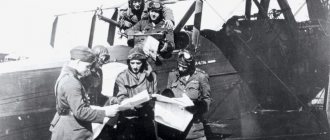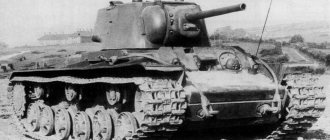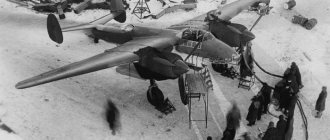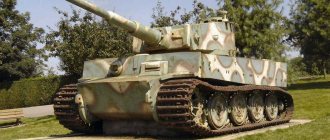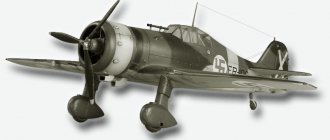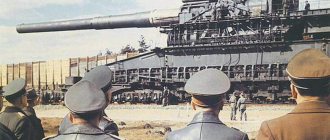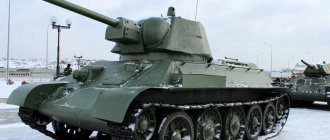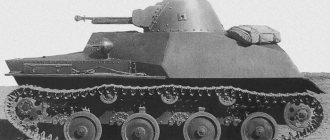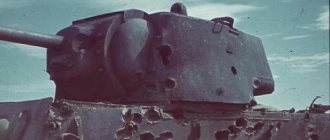Even at the stage of fine-tuning the Manchester, R. Chadwick, due to problems with the Valchur engines, proposed several alternative options for the development of the aircraft with engines of other types. In April 1940, Avro's proposals were considered by the Ministry of Aviation, which chose the Manchester Mk.III project for implementation - a four-engine vehicle powered by Rolls-Royce Merlin engines. In addition to replacing the outer parts of the wing with new ones, increased in span and with an additional pair of engines, the center section was strengthened, the capacity of the fuel tanks was increased, and other improvements were made.
received an order for the construction (by converting from Manchesters already under construction) four prototypes of the aircraft, called Lancaster, the first of which entered testing on January 9, 1941. It had a three-fin tail and Merlin X engines (1145 hp ). The second vehicle was equipped with a twin-fin tail (as on the Manchester Mk.IA), Merlin XX engines (1280 hp) and a full set of defensive weapons (8 Browning machine guns - 2 each in the bow and top turrets and 4 - in the tail). The third prototype received Bristol Hercules VI air-cooled engines, but the construction of the fourth was abandoned - the test results of the first three machines were so good that the aircraft was put into production.
On October 31, 1941, the first production Lancaster Mk.I was released in Woodford. Subsequently, the production of Lancasters was also established at Trafford Park, Armstrong Whitworth in Baginton, Vickers Armstrong in Castle Bromwich and Austin Motors in Longbridge. In addition, Lancasters were also built in Canada, at (later renamed Avro Canada) in Toronto. Their production began in August 1943. Until the production of serial aircraft was completed on February 2, 1946, 7377 Lancaster aircraft were built in Great Britain and Canada, thus becoming the most popular British four-engine aircraft.
Rain and fog
The empire, living in the grip of rain and fog, did not pay much attention to aviation in the 20s and early 30s, but the premonition of a new world war by the end of the 30s changed everything.
Active work began on new types of bombers, fighters and other types of aircraft. At that time, the British were significantly ahead of not only the Germans, but also the “rebel colonists” - it was not for nothing that the Americans later actively and happily used English engines in World War II. While creating cars that met the requirements of the late 30s, the British also thought about much larger projects.
Baptism of fire
The Lancaster's first combat mission was made in March 1942, during which they mined the Heligoland Bight. On March 10-11, Lancasters bombed the German city of Essen.
In April of the same year, 12 Lancasters made a daytime raid on a MAN diesel plant. The result of the raid was sad. 4 aircraft were lost on the way to the target, 3 more were shot down on the way back, and all 5 aircraft that returned were damaged.
Despite the high level of losses from German air defense during daytime raids, the British were forced to continue them due to the low effectiveness of night bombing, because according to intelligence data, only 50% of the bombs dropped fell in the target area, in addition, three out of four crews even were not sure if they had even detected the target.
Bombing accuracy improved significantly only with the introduction of the H2S airborne radar, designed for navigation purposes and determining the position of targets. But this step later led to sad consequences, which will be discussed below.
On May 16, 1943, nineteen Lancasters bombed three dams. The Zorpe dam was damaged, and the Men and Eder dams were destroyed. The torrent of water flooded the Ruhr Valley, killing more than 1,200 people and causing enormous damage to the industry of this industrial region of Germany. Of the 19 Lancasters sent to the raid, eight vehicles did not return to their base.
Failed Victory
Back in 1937, she proactively began work on a huge high-altitude bomber. It was assumed that due to its flight altitude and speed, such a machine would be absolutely invulnerable to fighters, so it was not even planned to install defensive turrets on it. But this plane could deliver ten tons of bombs to any German enterprises with a flight from France. Also based on it, it was planned to develop a passenger airliner capable of, among other things, transatlantic flights.
The 1937 project was a development of the B.12/36 long-range bomber program - from there the placement of the main bomb bay in the wing was inherited. The picture shows the Armstrong-Whitworth project within the framework of specification B.12/36
Until 1940, work progressed slowly, and even the outbreak of World War II did not immediately fuel interest in the car. Only in the summer of 1940 did the British military decide to start financing the project, which bore the rather laconic name Long-Range High-Altitude Bomber (“long-range high-altitude bomber”). There were several reasons for this. The first, of course, is the loss of France. Now British bombers had to fly from the island, and the Germans quickly deployed aviation to the occupied territory. Here the advantages of the Vickers project came to the fore - everything was fine with the range, and the flight altitude made it possible to simply ignore the interceptors.
The second reason is also related to range - the British considered the USSR as an ally of the Reich and seriously planned to start a war with it. And the new bomber was perfect for raids on Moscow or the Urals.
An early version of the Vickers ultra-long-range bomber. The lack of defensive weapons is clearly visible
In 1941, the bomber idea was complemented by the idea of a new weapon. Vickers engineer Barnes Wallace came up with the idea of a so-called seismic bomb - a huge bomb with a streamlined body that could go deep into the ground before detonating and create a local earthquake. The bomber being developed was ideal for such ammunition. It is interesting that Wallace also came up with a new name for the entire project as a whole - instead of the boring “long-range high-altitude bomber”, he proposed the loud and beautiful Victory Bomber - “Victory Bomber”.
Dropping a seismic bomb from an Avro Lancaster bomber
Purge model of the late Victory Bomber variant
Around the same time, another idea was born, much less “victorious”. In the event of a successful German invasion of England, it was planned to quickly evacuate the government, the royal family and as much military industry as possible to the dominions - mainly to Canada. From there, Britain would have continued the war with the Reich. This mission required intercontinental bombers, and Victory was perfect for this role. Fortunately, with American help, Canada has already begun to build suitable aircraft factories. The original project did not have such a range, but Vickers engineers promised that increasing it to the required levels would not be so difficult.
Late version of the Victory Bomber: due to the increased performance of German interceptors, defensive weapons were returned to the aircraft
The new is the well-forgotten old
Development of the Lancaster began when the war had already been going on in Europe for three months. An analysis of air battles showed that if one of the engines of the main twin-engine medium bomber "Manchester" of the British Air Force fails, it will not be able to return to the departure airfield. Then the English designers came up with a brilliant option: to make... a new 4-engine bomber from the 2-engine Manchester.
The plane received a longer wing, an old fuselage, and 4 Rolls-Royce Merlin XX engines. It took off on January 9, 1941. The aircraft showed much better performance than its predecessor, and soon entered mass production under the name "Lancaster" (named after a small English town).
One hundred tons of perversions
75-ton bomber from
By 1942, the rough design of the Victory was completed, the project even went through the stage of purging in a wind tunnel. But by that time the interest of the military had dropped significantly. Germany got involved in a long war in the east, which means there was no longer any point in bombing the USSR, and the Germans would not have gotten around to a possible invasion of the Island soon. In addition, the military considered seismic bombs to be self-indulgence and insisted on developing a bomber for conventional bombs.
In the fall of 1942, work on the Victory was stopped, but the military had not yet lost interest in the huge bombers. Instead of the old project, they launched a new one, this time on a competitive basis. It is known under two names - “75-ton bomber”, because this is the weight the military wanted, or “100-ton bomber”, because most of the projects came out that way.
75-ton bomber from Handley Page
The main changes affected the required flight altitude; Victory's nine and a half kilometers were already outdated by that time, and the military expected to get at least ten and a half. The payload requirement has also increased to a maximum of 20-25 tons. The speed of 600 kilometers per hour at three kilometers and the range of four thousand kilometers with a full load or six thousand with half remained unchanged. The main theater for the use of such an aircraft was considered the Pacific Ocean, because, in principle, existing bombers were sufficient against Germany. Plus, the new vehicle was to become the basis of Britain's bomber fleet after the war.
Hundred-ton bomber from Vickers, diagram A
Hundred-ton bomber from Vickers, diagram B. Noteworthy is the abundance of defensive weapons
A similar project, which promised excellent profits, attracted almost all major aircraft manufacturers in England. Both quite ordinary planes and those that were completely “traveled” were presented. They offered both tailless and canard bombers, flying wings, longitudinal biplanes and vehicles with pusher propellers.
Of all the competitors, by 1943, Bristol gradually took the lead. The former initially developed five layout options. Option A was an ordinary bomber of the familiar English “flying chest” style, only of enormous size. Option B resembled A, but had pusher propellers. Options C and D were made according to the “canard” design and also differed in pushing and pulling propellers. Finally, the E was a typical tailless aircraft. Of all these options, Scheme C was chosen for the final work, as it most meets the requirements of the military.
Hundred-ton bomber from Vickers, scheme C
Hundred-ton bomber from Vickers, diagram E
The Bristol project was carried out according to the usual design, but using pusher screws. It was in many ways similar to similar projects in the USA and Germany. It is not surprising that the British military leaned towards him. But while engineers were designing bombers, the situation had changed dramatically. By the summer of 1943, it became clear that the creation of such giants would take a long time, and there was no point in this work. Instead, it was decided to focus efforts on the production of the already mastered Avro Lancaster and the new Avro Lincoln.
Hundred-ton bomber from Bristol
DIVE BOMBERS
Great Britain
| Aircraft type | Blackburn Skua | Hawker Henley | Fairey P.4/34 |
| Wingspan, feet inches (m) | 46 2 (14.07 m) | 47 10,5 (14,59) | 47 4,5 (14,44) |
| Wing area, sq. ft (m²) | 312 (28,99) | 342 (31,77) | 346 (32,14) |
| Specific wing load, sq. ft (m²) | 21,8 (106,4) | 26,4 (128,9) | 25,4 (124,0) |
| Total weight, lbs (kg) | 6811 (3089) | 9050 (4105) | 8787 (3986) |
| Payload, lbs (kg) | 1321 (600) | 3350 (1520) | 2382 (1080) |
| engine's type | Bristol Perseus XII | Rolls-Royce Merlin II | Rolls-Royce Merlin II |
| Cooling | air | liquid | liquid |
| Total rated power, hp | 745 | 990 | 990 |
| Maximum speed, miles per hour (km/h) | 225 (362) | 300 (483) | 284 (457) |
| at height, feet (m) | 6500 (1981) | 17500 (5334) | 17200 (5243) |
| Elevation gain, feet (m) | — | 19680 (6000) | — |
| in time, min | — | 15 | — |
| Service ceiling, feet (m) | 20200 (6157) | 29000 (8840) | 29600 (9020) |
| Typical weapons | |||
| rifle caliber machine guns, pcs. | 5 | 2 | 2 |
| heavy machine guns, pcs. | — | — | — |
| guns, pcs. | — | — | — |
| Status | discontinued | IS | in production |
USA
| Aircraft type | Bell BG-1 | Brewster XSBA-1 (138) | Curtiss SBC-4 (Helldiver 77) | Douglas DB-19 | Vought SB2U-1 (V.156) |
| Wingspan, feet inches (m) | 36 0 (10,97) | 39 0 (11,89) | 34 0 (10,36) | 41 6 (12,65) | 42 0 (12,80) |
| Wing area, sq. ft (m²) | 353,8 (24,06) | 259 (24,06) | 317 (29,45) | 318,6 (29,6) | 305,3 (28,36) |
| Specific wing load, sq. ft (m²) | 17,3 (84,5) | 23,16 (113,1) | 18,0 (87,9) | 20,5 (100) | 21,3 (104) |
| Total weight, lbs (kg) | 6641 (3012) | 6000 (2722) | 5710 (2590) | 6527 (2960,6) | 6500 (2948) |
| Payload, lbs (kg) | 2821 (1280) | 2000 (907) | 1544 (700) | 2025 (919) | 2000 (907) |
| engine's type | Wright Cyclone F56 | Wright Cyclone G | Wright Cyclone G3 | Pratt and Whitney Twin Wasp Jr. | Pratt and Whitney Twin Wasp Jr. |
| Cooling | air | air | air | air | air |
| Total rated power, hp | 755 | 750 | 840 | 750 | 750 |
| Maximum speed, miles per hour (km/h) | 206 (332) | 285 (459) | 235 (378) | 223 (359) | 257 (414) |
| at height, feet (m) | 11300 (3444) | — | 9800 (2987) | — | — |
| Elevation gain, feet (m) | — | — | — | — | — |
| in time, min | — | — | — | — | — |
| Service ceiling, feet (m) | 24950 (7605) | — | 25700 (7833) | 25000 (7620) | 28200 (8595) |
| Typical weapons | |||||
| rifle caliber machine guns, pcs. | 2 | 2 | 2 | 2 | 2 |
| heavy machine guns, pcs. | — | — | — | — | — |
| guns, pcs. | — | — | — | — | — |
| Status | Products available for order | in production | IS | IS | IS |
Germany and the Netherlands
| Aircraft type | Blohm and Voss Ha.137 | Junkers Ju.87 | Fokker G.I. |
| Wingspan, feet inches (m) | 36 7 (11,15) | 45 4 (13,82) | 54 1,5 (16,50) |
| Wing area, sq. ft (m²) | 252,8 (23,5) | 344 (32) | 384 (35,7) |
| Specific wing load, sq. ft (m²) | 21 (102,5) | 26,7 (130,36) | 27 (131,8) |
| Total weight, lbs (kg) | 5313 (2410) | 9200 (4173) | 11243 (5100) |
| Payload, lbs (kg) | 1320 (600) | 3000 (1361) | 3637 (1650) |
| engine's type | Junkers Jumo 210 | Junkers Jumo 211 | Bristol Perseus X |
| Cooling | liquid | liquid | air |
| Total rated power, hp | 680 | 940 | 1460 |
| Maximum speed, miles per hour (km/h) | 205 (330) | 240 (386) | 300 (483) |
| at height, feet (m) | 6560 (2000) | — | — |
| Elevation gain, feet (m) | 13120 (4000) | — | 19680 (6000) |
| in time, min | 9 | — | 11 |
| Service ceiling, feet (m) | 22960 (7000) | 25000 (7620) | 29000 (8840) |
| Typical weapons | |||
| rifle caliber machine guns, pcs. | 2 | 3 | 5 |
| heavy machine guns, pcs. | — | — | — |
| guns, pcs. | — | — | — |
| Status | PA | IS | in production |
source: “BOMBERS” “FLIGHT” MARCH 14, 1940, pp. 222-233, 246
The need for invention is cunning
During the “Battle of Hamburg” in 1943, measures to “blind” German radars using the “Window” system turned out to be very effective, which practically paralyzed the city’s air defense.
The Window consisted of aluminum foil glued to a black paper backing and cut into strips 30 cm long and 1.5 cm wide.
The shiny side was coated with lamp black so that the foil clouds would not sparkle in the spotlight but would continue to reflect radio waves. British planes were not visible on radar in the clouds of this foil and German anti-aircraft guns could not fire accurately.
But the Germans were not asleep either. They developed equipment capable of pointing their fighters at English ones based on signals from H2S locators located on English planes!
In addition, German fighters began to be equipped with upward-firing cannons. The enemy's use of these new products led to a sharp increase in Lancaster losses during the winter and spring of 1944. It is not surprising that on March 30, during the raid on Nuremberg, 96 of the 795 British aircraft participating in it were shot down.
However, by April 1945, the number of Lancasters in Bomber Command had reached its peak, with no less than 56 squadrons armed with these bombers.
Hunt for Tirpitz
On September 11, 1944, 38 Lancasters with enlarged bomb bays containing Tallboy bombs took off from England to Yagodnik near Arkhangelsk in the Soviet Union to prepare a raid on the German battleship Tirpitz anchored in Alten Fjord in Norway. This attack took place on September 15th.
Soviet navigators led them to the target. Our planes also conducted preliminary reconnaissance and then photographed the results of the raid. Of the 21 super-powerful Tallboy bombs (six vehicles carried conventional 224 kg armor-piercing bombs), one hit the battleship directly. Several smaller ones also hit the target. However, Tirpitz remained afloat. The British had no losses.
After repeated attacks from the air and from under water, the Tirpitz was finally sunk by Lancasters while docked in Tromsø on November 12, 1944 as a result of an air raid using super-heavy 5.5-ton Tallboy bombs.
Lancaster peace mission
On the last combat mission of the war, the Lancasters flew on April 25, 1945 to bomb Hitler’s hideout in Berchtesgaden. The Lancasters then delivered food to residents of Dutch cities who lacked food. Over 3,156 sorties, more than 6,000 tons of food were dropped.
In May 1945, Lancasters transported about 74,000 prisoners of war liberated from German camps from Germany to Great Britain.
"Lancasters" were used as rescue aircraft in the Pacific Ocean, photographic reconnaissance aircraft for aerial photography of a number of areas in Africa. But most of the Lancasters that survived the war were scrapped.
But they left an unforgettable mark on the history of aviation. Today, the only flying example of the Lancaster is in England in the Royal Air Force Museum.


